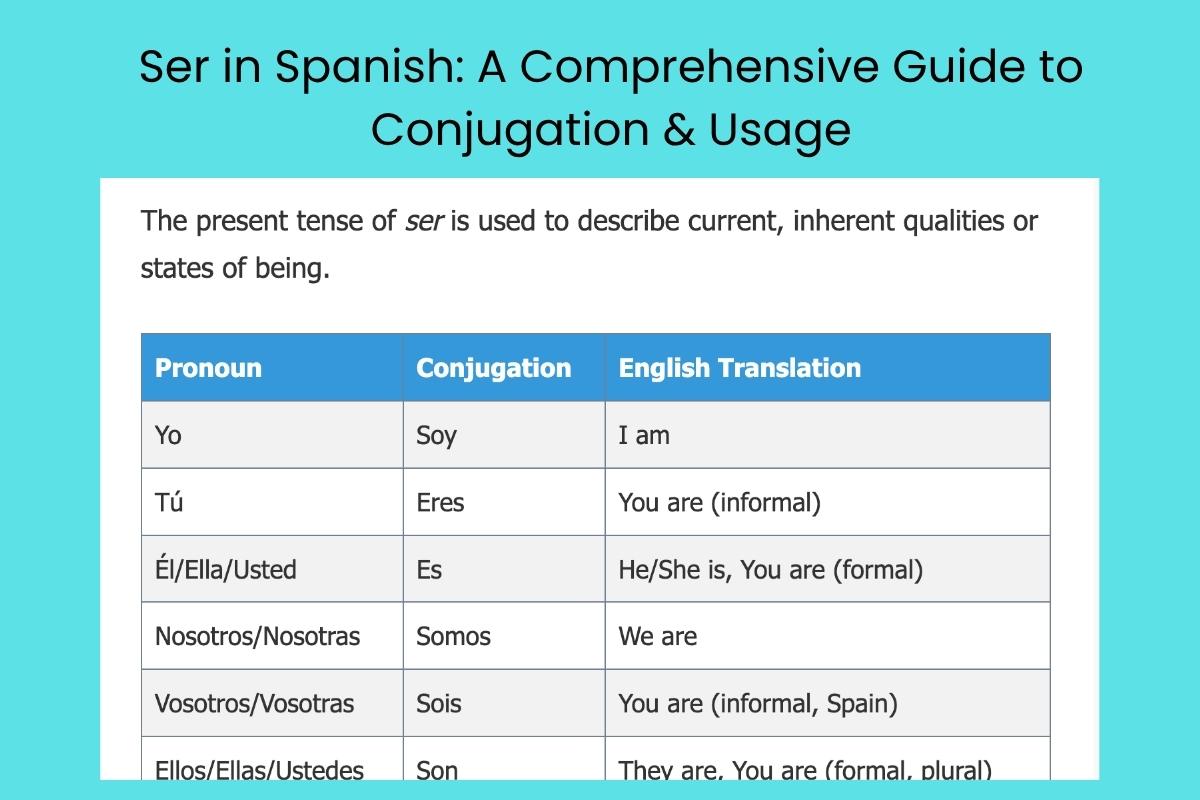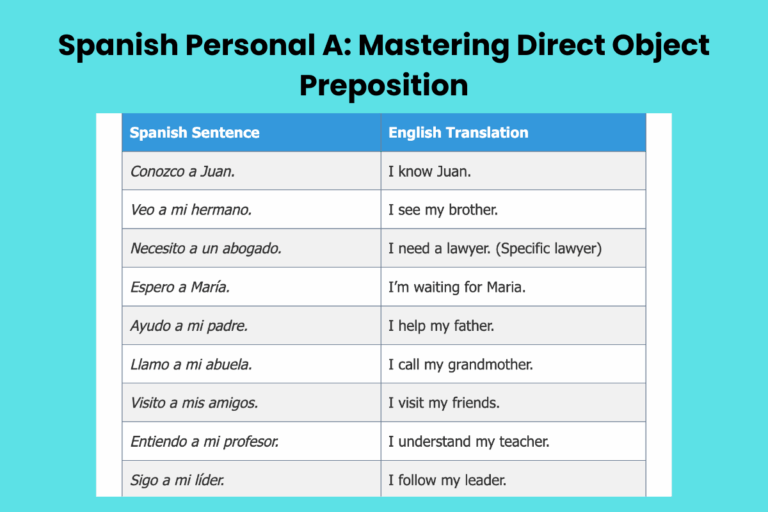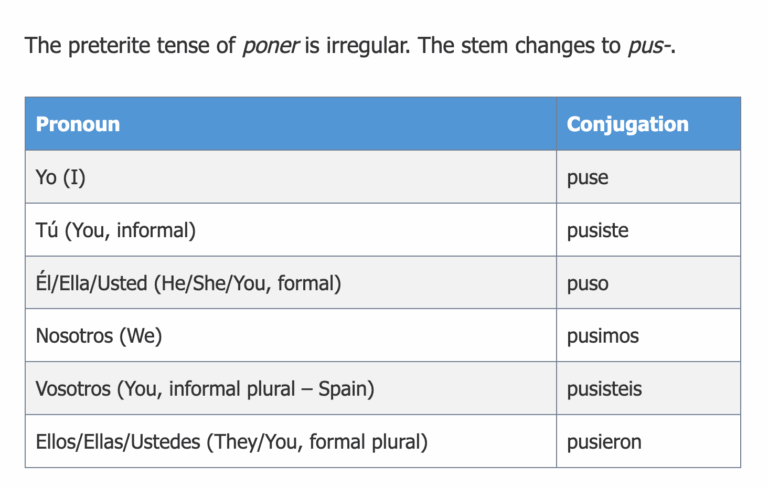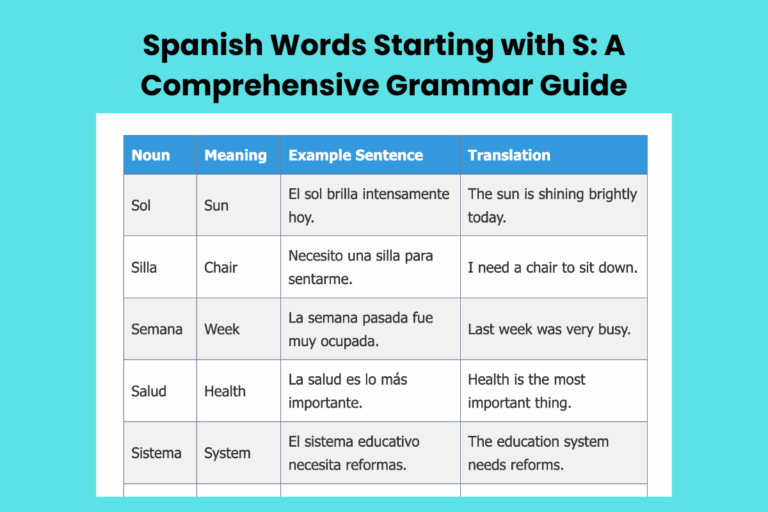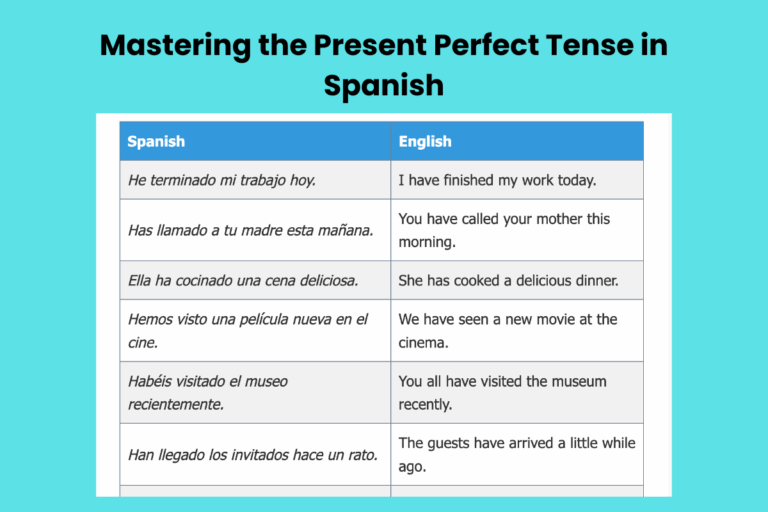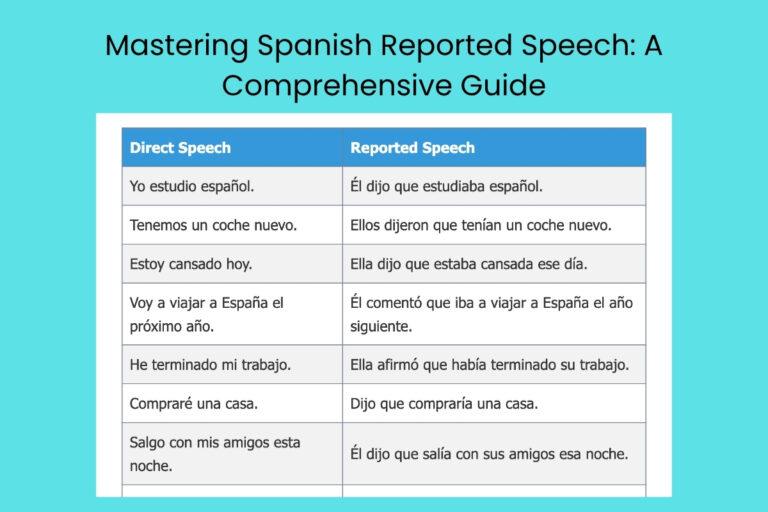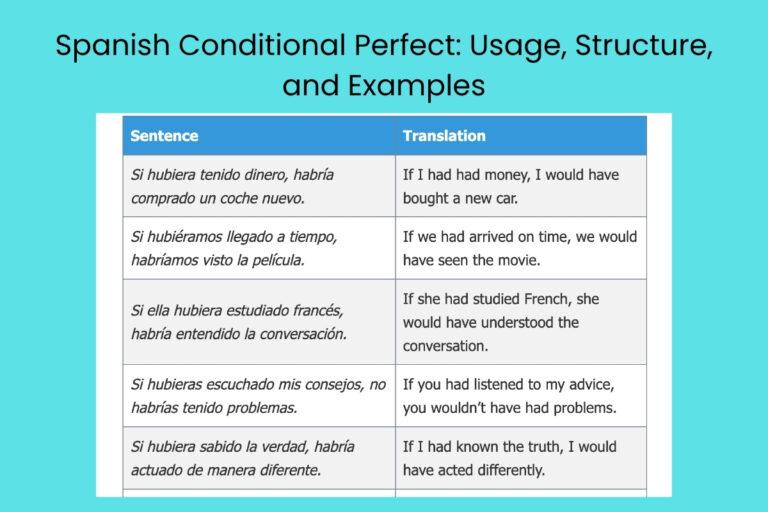Ser in Spanish: A Comprehensive Guide to Conjugation & Usage
Mastering the Spanish verb ser is crucial for anyone learning the language. It’s one of the most fundamental verbs, used to express permanent or inherent characteristics, origin, identity, and much more. Understanding ser is essential for building a strong foundation in Spanish grammar and for expressing yourself accurately and confidently. This article provides a comprehensive guide to the conjugation and usage of ser, suitable for learners of all levels, from beginners to advanced students. By the end of this guide, you’ll have a solid grasp of how to use ser correctly in a variety of contexts.
Table of Contents
- Introduction
- Definition of Ser
- Structural Breakdown
- Conjugation of Ser
- Usage Rules of Ser
- Examples of Ser in Use
- Common Mistakes with Ser
- Practice Exercises
- Advanced Topics
- FAQ
- Conclusion
Definition of Ser
The Spanish verb ser is one of the two verbs that translate to “to be” in English (the other being estar). However, ser is generally used to describe permanent or inherent qualities, characteristics that define a person, place, or thing. It denotes identity, origin, inherent traits, and more lasting attributes. It’s a crucial verb to understand because it helps convey essential information about the nature of the subject.
Ser is an irregular verb, meaning its conjugation doesn’t follow the standard patterns of regular Spanish verbs. This irregularity makes it important to memorize its various forms. The correct usage of ser is essential for clear communication because using estar instead can drastically change the meaning of a sentence. For instance, saying “Soy cansado” (using ser) implies that tiredness is a permanent characteristic, which is incorrect. The correct way to say “I am tired” is “Estoy cansado” (using estar), indicating a temporary state.
Functionally, ser acts as a linking verb, connecting the subject of a sentence to a noun, pronoun, or adjective that describes or identifies it. This linking function is vital for expressing identity, characteristics, and relationships. Consider the sentence “Ella es doctora” (She is a doctor). Here, es (the conjugated form of ser) links the subject ella (she) to the noun doctora (doctor), identifying her profession. Understanding this linking role is fundamental to grasping the function of ser in Spanish.
Structural Breakdown
The basic structure using ser typically involves a subject, the conjugated form of ser, and a complement. This complement can be a noun, an adjective, or a prepositional phrase that provides information about the subject. The structure follows the pattern: Subject + Ser (conjugated) + Complement.
The complement provides essential information about the subject; it can describe a quality, identify a profession, indicate a relationship, or express origin. For example, in the sentence “El libro es interesante” (The book is interesting), “interesante” (interesting) is the adjective complement describing the quality of the book. Similarly, in “Nosotros somos estudiantes” (We are students), “estudiantes” (students) is the noun complement identifying who we are.
The conjugation of ser changes depending on the tense and the subject pronoun. Each pronoun (yo, tú, él/ella/usted, nosotros/nosotras, vosotros/vosotras, ellos/ellas/ustedes) has a unique conjugation in each tense, which must be memorized. For example, in the present tense, the conjugations are: yo soy, tú eres, él/ella/usted es, nosotros/nosotras somos, vosotros/vosotras sois, ellos/ellas/ustedes son. Understanding this conjugation pattern is crucial for constructing grammatically correct sentences.
Conjugation of Ser
The verb ser is irregular, meaning its conjugations don’t follow standard patterns. Here’s a breakdown of its conjugation in various tenses.
Present Tense
The present tense of ser is used to describe current, inherent qualities or states of being.
| Pronoun | Conjugation | English Translation |
|---|---|---|
| Yo | Soy | I am |
| Tú | Eres | You are (informal) |
| Él/Ella/Usted | Es | He/She is, You are (formal) |
| Nosotros/Nosotras | Somos | We are |
| Vosotros/Vosotras | Sois | You are (informal, Spain) |
| Ellos/Ellas/Ustedes | Son | They are, You are (formal, plural) |
Preterite Tense
The preterite tense of ser is used to describe actions or states of being that were completed in the past.
| Pronoun | Conjugation | English Translation |
|---|---|---|
| Yo | Fui | I was |
| Tú | Fuiste | You were (informal) |
| Él/Ella/Usted | Fue | He/She was, You were (formal) |
| Nosotros/Nosotras | Fuimos | We were |
| Vosotros/Vosotras | Fuisteis | You were (informal, Spain) |
| Ellos/Ellas/Ustedes | Fueron | They were, You were (formal, plural) |
Imperfect Tense
The imperfect tense of ser describes ongoing or habitual actions or states of being in the past. It’s used for descriptions, background information, and repeated actions.
| Pronoun | Conjugation | English Translation |
|---|---|---|
| Yo | Era | I was (used to be) |
| Tú | Eras | You were (used to be, informal) |
| Él/Ella/Usted | Era | He/She was (used to be), You were (used to be, formal) |
| Nosotros/Nosotras | Éramos | We were (used to be) |
| Vosotros/Vosotras | Erais | You were (used to be, informal, Spain) |
| Ellos/Ellas/Ustedes | Eran | They were (used to be), You were (used to be, formal, plural) |
Future Tense
The future tense of ser expresses what will be in the future.
| Pronoun | Conjugation | English Translation |
|---|---|---|
| Yo | Seré | I will be |
| Tú | Serás | You will be (informal) |
| Él/Ella/Usted | Será | He/She will be, You will be (formal) |
| Nosotros/Nosotras | Seremos | We will be |
| Vosotros/Vosotras | Seréis | You will be (informal, Spain) |
| Ellos/Ellas/Ustedes | Serán | They will be, You will be (formal, plural) |
Conditional Tense
The conditional tense of ser expresses what would be, often used in hypothetical situations.
| Pronoun | Conjugation | English Translation |
|---|---|---|
| Yo | Sería | I would be |
| Tú | Serías | You would be (informal) |
| Él/Ella/Usted | Sería | He/She would be, You would be (formal) |
| Nosotros/Nosotras | Seríamos | We would be |
| Vosotros/Vosotras | Seríais | You would be (informal, Spain) |
| Ellos/Ellas/Ustedes | Serían | They would be, You would be (formal, plural) |
Subjunctive Mood
The subjunctive mood is used to express doubts, wishes, possibilities, or hypothetical situations. It is often used in subordinate clauses following certain verbs or expressions.
Present Subjunctive
| Pronoun | Conjugation | English Translation |
|---|---|---|
| Yo | Sea | That I be |
| Tú | Seas | That you be (informal) |
| Él/Ella/Usted | Sea | That he/she be, That you be (formal) |
| Nosotros/Nosotras | Seamos | That we be |
| Vosotros/Vosotras | Seáis | That you be (informal, Spain) |
| Ellos/Ellas/Ustedes | Sean | That they be, That you be (formal, plural) |
Imperfect Subjunctive
There are two forms of the imperfect subjunctive. Both are equally correct and used, although one form might be more common in certain regions or contexts.
We’ll present both.
| Pronoun | Conjugation | English Translation |
|---|---|---|
| Yo | Fuera | That I were |
| Tú | Fueras | That you were (informal) |
| Él/Ella/Usted | Fuera | That he/she were, That you were (formal) |
| Nosotros/Nosotras | Fuéramos | That we were |
| Vosotros/Vosotras | Fuerais | That you were (informal, Spain) |
| Ellos/Ellas/Ustedes | Fueran | That they were, That you were (formal, plural) |
| Pronoun | Conjugation | English Translation |
|---|---|---|
| Yo | Fuese | That I were |
| Tú | Fueses | That you were (informal) |
| Él/Ella/Usted | Fuese | That he/she were, That you were (formal) |
| Nosotros/Nosotras | Fuésemos | That we were |
| Vosotros/Vosotras | Fueseis | That you were (informal, Spain) |
| Ellos/Ellas/Ustedes | Fuesen | That they were, That you were (formal, plural) |
Imperative Mood
The imperative mood is used to give commands or make requests. Ser has very limited use in the imperative, mostly in formal commands.
| Pronoun | Conjugation | English Translation |
|---|---|---|
| Usted | Sea | Be (formal) |
| Ustedes | Sean | Be (formal, plural) |
Usage Rules of Ser
Understanding when to use ser is just as important as knowing its conjugations. Here are the primary usage rules:
Descriptions and Characteristics
Use ser to describe inherent qualities, personality traits, physical attributes, and other characteristics that are generally considered permanent or lasting.
Origin and Nationality
Ser is used to indicate where someone or something is from, including nationality and place of origin.
Identification and Definition
Use ser to identify people, objects, or concepts, and to provide definitions.
Time and Date
Ser is used to express the time, day, and date.
Occupation
Use ser to state someone’s profession or occupation.
Relationships
Ser is used to describe relationships between people.
Possession
While less common, ser can be used with the preposition “de” to indicate possession or ownership. More frequently, the verb *tener* is used to indicate possession.
Events
Ser is used to indicate where an event is taking place.
Passive Voice
Ser is used to form the passive voice, indicating that the subject is receiving the action, not performing it.
Examples of Ser in Use
Let’s look at examples of ser used in various contexts to illustrate the rules discussed above.
Descriptions and Characteristics Examples
| Spanish Sentence | English Translation |
|---|---|
| Ella es inteligente. | She is intelligent. |
| El coche es rojo. | The car is red. |
| La casa es grande. | The house is big. |
| Nosotros somos altos. | We are tall. |
| El libro es interesante. | The book is interesting. |
| La película fue aburrida. | The movie was boring. |
| Ellos son amables. | They are kind. |
| La fiesta será divertida. | The party will be fun. |
| La música es ruidosa. | The music is loud. |
| El café es caliente. | The coffee is hot. |
| La nieve es fría. | The snow is cold. |
| El examen es difícil. | The exam is difficult. |
| La vida es bella. | Life is beautiful. |
| El problema es complicado. | The problem is complicated. |
| La situación es grave. | The situation is serious. |
| El clima es agradable. | The weather is pleasant. |
| Mi perro es juguetón. | My dog is playful. |
| La ciudad es moderna. | The city is modern. |
| El arte es subjetivo. | Art is subjective. |
| La verdad es importante. | The truth is important. |
| La lección es clara. | The lesson is clear. |
| El ejercicio es útil. | The exercise is useful. |
| La respuesta es correcta. | The answer is correct. |
| El edificio es antiguo. | The building is old. |
| La vista es impresionante. | The view is impressive. |
Origin and Nationality Examples
| Spanish Sentence | English Translation |
|---|---|
| Yo soy de España. | I am from Spain. |
| Tú eres mexicano. | You are Mexican (informal). |
| Él es americano. | He is American. |
| Ella es italiana. | She is Italian. |
| Nosotros somos canadienses. | We are Canadian. |
| Vosotros sois ingleses. | You are English (informal, Spain). |
| Ellos son franceses. | They are French. |
| Usted es alemán. | You are German (formal). |
| Ustedes son japoneses. | You are Japanese (formal, plural). |
| El vino es de Francia. | The wine is from France. |
| La pizza es de Italia. | The pizza is from Italy. |
| El coche es de Alemania. | The car is from Germany. |
| Las flores son de Holanda. | The flowers are from Holland. |
| La música es de Cuba. | The music is from Cuba. |
| El tango es de Argentina. | The tango is from Argentina. |
| El chocolate es de Suiza. | The chocolate is from Switzerland. |
| Yo soy peruano. | I am Peruvian. |
| Tú eres colombiano. | You are Colombian (informal). |
| Él es venezolano. | He is Venezuelan. |
| Ella es chilena. | She is Chilean. |
| Nosotros somos ecuatorianos. | We are Ecuadorian. |
| Vosotros sois españoles. | You are Spanish (informal, Spain). |
| Ellos son portugueses. | They are Portuguese. |
| Usted es ruso. | You are Russian (formal). |
| Ustedes son chinos. | You are Chinese (formal, plural). |
Identification and Definition Examples
| Spanish Sentence | English Translation |
|---|---|
| Yo soy un estudiante. | I am a student. |
| Tú eres mi amigo. | You are my friend (informal). |
| Él es el profesor. | He is the teacher. |
| Ella es mi hermana. | She is my sister. |
| Nosotros somos un equipo. | We are a team. |
| Vosotros sois mis compañeros. | You are my classmates (informal, Spain). |
| Ellos son los ganadores. | They are the winners. |
| Usted es el director. | You are the director (formal). |
| Ustedes son los clientes. | You are the clients (formal, plural). |
| Esto es un libro. | This is a book. |
| Eso es una mesa. | That is a table. |
| Aquello es un edificio. | That (over there) is a building. |
| La honestidad es una virtud. | Honesty is a virtue. |
| El amor es un sentimiento. | Love is a feeling. |
| La paciencia es importante. | Patience is important. |
| La felicidad es un estado mental. | Happiness is a state of mind. |
| La democracia es un sistema político. | Democracy is a political system. |
| El socialismo es una ideología. | Socialism is an ideology. |
| El capitalismo es un sistema económico. | Capitalism is an economic system. |
| La biología es una ciencia. | Biology is a science. |
| La física es una ciencia. | Physics is a science. |
| La química es una ciencia. | Chemistry is a science. |
| La geografía es una ciencia. | Geography is a science. |
| Él es mi padre. | He is my father. |
| Ella es mi madre. | She is my mother. |
Time Examples
| Spanish Sentence | English Translation |
|---|---|
| Es la una. | It is one o’clock. |
| Son las dos. | It is two o’clock. |
| Es el lunes. | It is Monday. |
| Hoy es martes. | Today is Tuesday. |
| Mañana es miércoles. | Tomorrow is Wednesday. |
| Ayer fue domingo. | Yesterday was Sunday. |
| Es el 5 de mayo. | It is May 5th. |
| Es mediodía. | It is noon. |
| Es medianoche. | It is midnight. |
| La fiesta es el sábado. | The party is on Saturday. |
| El concierto es el viernes. | The concert is on Friday. |
| Mi cumpleaños es el 10 de junio. | My birthday is June 10th. |
| La reunión es a las tres. | The meeting is at three o’clock. |
| Hoy es el primer día del mes. | Today is the first day of the month. |
| Mañana será el último día del año. | Tomorrow will be the last day of the year. |
| Era la una y media. | It was half past one. |
| Eran las cinco de la tarde. | It was five in the afternoon. |
| Fue el 25 de diciembre. | It was December 25th. |
| Será el año que viene. | It will be next year. |
| Será el día más feliz de mi vida. | It will be the happiest day of my life. |
| La boda será en primavera. | The wedding will be in spring. |
| El evento fue en verano. | The event was in summer. |
| La Navidad es en invierno. | Christmas is in winter. |
| El día de acción de gracias es en otoño. | Thanksgiving is in autumn. |
| Es un día especial. | It is a special day. |
Occupation Examples
| Spanish Sentence | English Translation |
|---|---|
| Yo soy profesor. | I am a teacher. |
| Tú eres estudiante. | You are a student (informal). |
| Él es médico. | He is a doctor. |
| Ella es enfermera. | She is a nurse. |
| Nosotros somos ingenieros. | We are engineers. |
| Vosotros sois abogados. | You are lawyers (informal, Spain). |
| Ellos son arquitectos. | They are architects. |
| Usted es gerente. | You are a manager (formal). |
| Ustedes son contadores. | You are accountants (formal, plural). |
| Mi padre es carpintero. | My father is a carpenter. |
| Mi madre es cocinera. | My mother is a cook. |
| Mi hermano es bombero. | My brother is a firefighter. |
| Mi hermana es policía. | My sister is a police officer. |
| Mi abuelo fue granjero. | My grandfather was a farmer. |
| Mi abuela era costurera. | My grandmother was a seamstress. |
| Él será un gran líder. | He will be a great leader. |
| Ella sería una buena presidenta. | She would be a good president. |
| Yo soy programador. | I am a programmer. |
| Tú eres diseñador. | You are a designer (informal). |
| Él es periodista. | He is a journalist. |
| Ella es secretaria. | She is a secretary. |
| Nosotros somos músicos. | We are musicians. |
| Vosotros sois artistas. | You are artists (informal, Spain). |
| Ellos son científicos. | They are scientists. |
| Usted es consultor. | You are a consultant (formal). |
Common Mistakes with Ser
One of the most common mistakes is confusing ser with estar. Remember, ser is generally used for permanent or inherent characteristics, while estar is used for temporary states or conditions. Using the wrong verb can significantly alter the meaning of a sentence.
Incorrect: Yo estoy alto. (I am tall.)
Correct: Yo soy alto. (I am tall.) (Height is a permanent characteristic.)
Incorrect: Ella es cansada. (She is tired.)
Correct: Ella está cansada. (She is tired.) (Tiredness is a temporary state.)
Another common mistake is incorrect conjugation, especially with irregular forms. Make sure to memorize the conjugations for each tense.
Incorrect: Yo era feliz ayer. (I was happy yesterday) – Using imperfect, implying a habitual state.
Correct: Yo fui feliz ayer. (I was happy yesterday.) – Using preterite, indicating a completed state.
Incorrect: Nosotros somos fuimos a la playa. (We were went to the beach.)
Correct: Nosotros fuimos a la playa. (We went to the beach.) – No need to use “ser” with “ir”.
Practice Exercises
Complete the
Advanced Topics
For advanced learners, exploring more nuanced uses of ser can enhance fluency. One such area is using ser in impersonal expressions, such as “Es importante estudiar” (It is important to study). These expressions often trigger the subjunctive mood in subordinate clauses.
Another advanced topic is the use of ser in passive constructions. For instance, “El libro fue escrito por Juan” (The book was written by Juan). Understanding how to form and use passive sentences is crucial for advanced proficiency.
Finally, recognizing subtle differences in meaning when choosing between ser and estar requires a deep understanding of context. Advanced learners should focus on mastering these nuances through extensive reading and practice.
FAQ
Conclusion
Mastering the verb ser is a fundamental step in learning Spanish. Its versatility and importance in expressing identity, characteristics, origin, and time make it an indispensable tool for effective communication. By understanding its conjugations and usage rules, and by practicing regularly, you can confidently and accurately use ser in a wide range of contexts. Keep practicing, and you’ll find that ser becomes second nature in your Spanish conversations.

